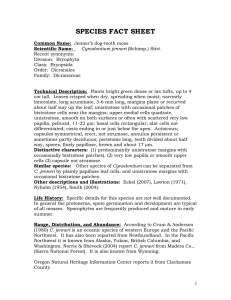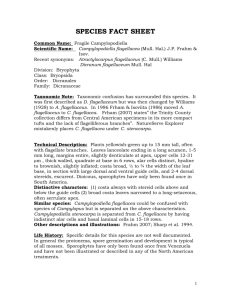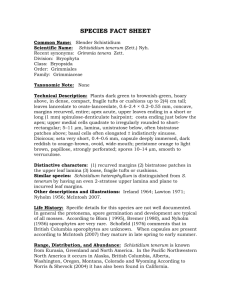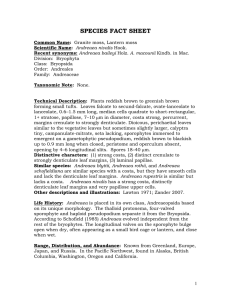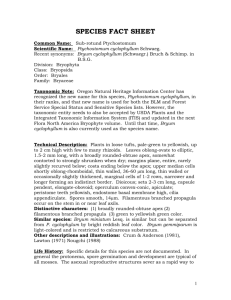SPECIES FACT SHEET
advertisement
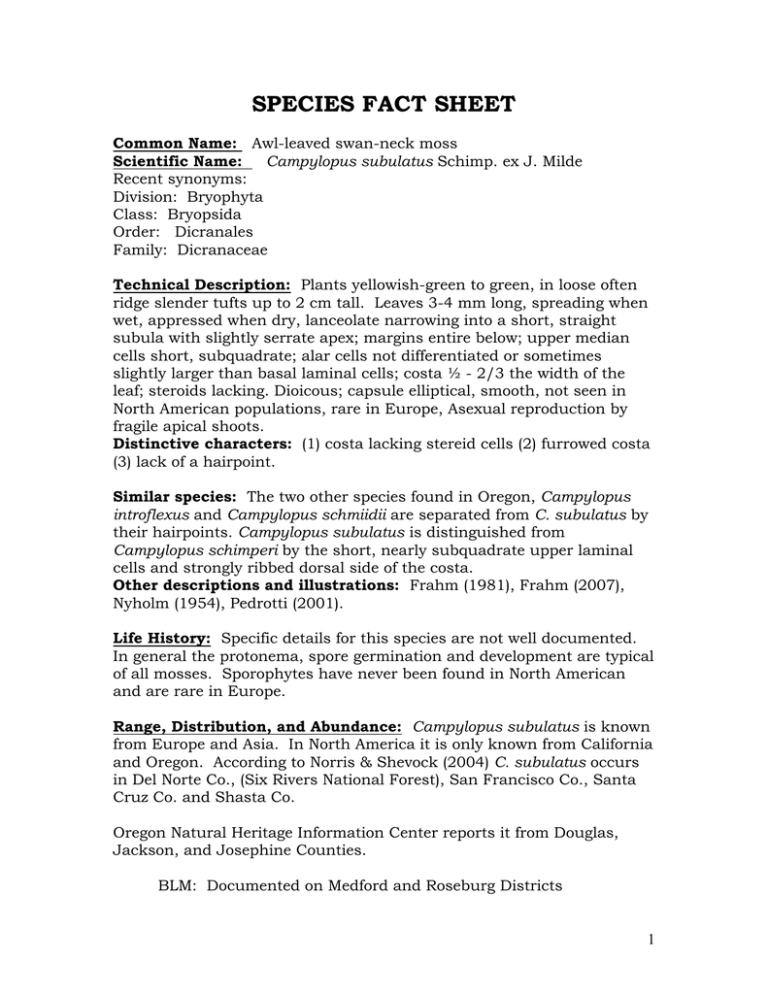
SPECIES FACT SHEET Common Name: Awl-leaved swan-neck moss Scientific Name: Campylopus subulatus Schimp. ex J. Milde Recent synonyms: Division: Bryophyta Class: Bryopsida Order: Dicranales Family: Dicranaceae Technical Description: Plants yellowish-green to green, in loose often ridge slender tufts up to 2 cm tall. Leaves 3-4 mm long, spreading when wet, appressed when dry, lanceolate narrowing into a short, straight subula with slightly serrate apex; margins entire below; upper median cells short, subquadrate; alar cells not differentiated or sometimes slightly larger than basal laminal cells; costa ½ - 2/3 the width of the leaf; steroids lacking. Dioicous; capsule elliptical, smooth, not seen in North American populations, rare in Europe, Asexual reproduction by fragile apical shoots. Distinctive characters: (1) costa lacking stereid cells (2) furrowed costa (3) lack of a hairpoint. Similar species: The two other species found in Oregon, Campylopus introflexus and Campylopus schmiidii are separated from C. subulatus by their hairpoints. Campylopus subulatus is distinguished from Campylopus schimperi by the short, nearly subquadrate upper laminal cells and strongly ribbed dorsal side of the costa. Other descriptions and illustrations: Frahm (1981), Frahm (2007), Nyholm (1954), Pedrotti (2001). Life History: Specific details for this species are not well documented. In general the protonema, spore germination and development are typical of all mosses. Sporophytes have never been found in North American and are rare in Europe. Range, Distribution, and Abundance: Campylopus subulatus is known from Europe and Asia. In North America it is only known from California and Oregon. According to Norris & Shevock (2004) C. subulatus occurs in Del Norte Co., (Six Rivers National Forest), San Francisco Co., Santa Cruz Co. and Shasta Co. Oregon Natural Heritage Information Center reports it from Douglas, Jackson, and Josephine Counties. BLM: Documented on Medford and Roseburg Districts 1 USFS: Documented on Siuslaw NF. This species is rare in North America, but may be under-collected or misidentified. Schofield (1976) states that C. subulatus is “very rare in the Province; known from a few sub-alpine localities.” Habitat Associations: According to Frham & Vitt, (1978) C. subulatus is a low elevation species with suboceanic tendency. In California, populations were found in an oak woodland, Douglas-fir forest and on sand dunes with Pinus contorta from 80-200 m. The Siuslaw NF site was located at Cape Perpetua, immediately along the Pacific coast. Threats: Road, trail or development at or near known locations could be a threat to this species. Off road vehicle traffic could threaten known locations. Over collecting for scientific purposes also could be a threat. Conservation Considerations: Verify the collections if not already done. Although unlikely to be confused with the two other species of Campylopus found in Oregon, this species could be confused with C. schimperi which is found in British Columbia but has not been reported from Washington or Oregon. Conservation Rankings and Status: Global: G3G5, Oregon (S1) Oregon: ORNHIC List 3 Washington: Not ranked BLM Strategic Species in Oregon Preparer: Judith A. Harpel Ph.D. Edited by: Rob Huff Date Completed: October 2008 Updated by R. Huff in January 2010 to reflect new site information on Roseburg BLM and Siuslaw NF Updated by David Wagner, May 2010 (Taxonomic Note deleted; Distribution updated; Citation added; Illustration appended.) Revised by Candace Fallon, February 2011(Revision adds Attachment 1, Photos) ATTACHMENTS: (1) Illustration (2) Photos 2 References: Frahm, J. 2007. Campylopus In Flora of North America North of Mexico. Bryophyta Vol. 27 Part 1: 366-376. Oxford Univ. Press. Oxford Frahm, J. 1981. Synopsis of the Genus Campylopus in North America North of Mexico. The Bryologist 83(4): 570-588. Frahm, J.-P., & D. Vitt. 1978. A Taxonomic study of Campylopus schimperi and C. subulatus (Bryopsida: Dicranaceae) in North America. Brittonia 30(3): 365-372. Frahm, J.-P. 2007. Campylopus. in FNA Editorial Committee. Flora of North America, vol. 27. Oxford University Press, New York. pp. 366-376. NatureServe Explorer. 2008. An Online Encyclopedia of Life. http://www.natureserve.org/explorer/ Norris, D. & J. Shevock. 2004. Contributions Toward a Bryoflora of California: I. A Specimen-Based Catalogue of Mosses. Madroño 51(1): 1-131. Nyholm, E. 1954. Illustrated Moss Flora of Fennoscandia. II Musci. Ed. by The Botanical Society of Lund. CWK Gleerup. Lund, Sweden. pp. 76-80. Pedrotti, Cortini Carmela. 2001. Flora dei muschi d’Italia, Sphagnopsida Andreaeopsida Bryopsida (1 parte). Antonio Delfino Editore medicina-scienze. Roma, Italy. 817 pp. Schofield, W. 1976. Bryophytes of BC III: habitat and distributional information for selected mosses. Syesis 9: 317-354. 3 Attachment 1 – Illustration From Flora of North America, vol. 27, p. 373. 4 Attachment 2 – Photos All photos by J. Harpel, under contract with the Oregon/Washington Bureau of Land Management. Alar and basal cells Lower medial cells Upper medial cells 5 Basal leaf cross section Composite cross sections 6 Leaf Leaf apex Leaf cross section 7 Whole mount dry Whole mount wet 8
